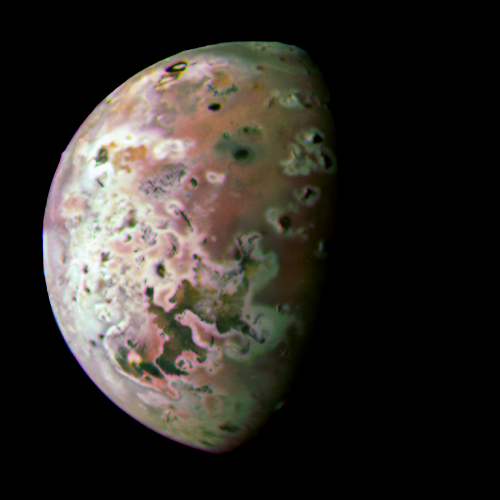Juno gets new close-up images of Jupiter’s moon Io
During its July close fly-by of Jupiter the orbiter Juno also flew past the moon Io, getting within 14,000 miles. The picture to the right, cropped and reduced to post here, was one of the images taken during that fly-by and subsequently processed and color enhanced by citizen scientist Thomas Thomopoulos.
The picture was taken at about the spacecraft’s closest point. It shows the splotched and volcanic surface of Io, which because it orbits close to Jupiter tidal forces cause it to have an intensely active volcanic surface. All the black features are either volcanoes or lava flows. This set of all of Juno’s Io images taken during the fly-by, enhanced by citizen scientist Gerald Eichstädt, also shows a volcanic plume in the shadowed portion of the planet, just beyond the terminator, which Eichstädt believes is a mountain dubbed Tohil Mons.
Even closer flybys are scheduled for December ’23 and February ’24, both getting within 1,000 miles of the surface.
On Christmas Eve 1968 three Americans became the first humans to visit another world. What they did to celebrate was unexpected and profound, and will be remembered throughout all human history. Genesis: the Story of Apollo 8, Robert Zimmerman's classic history of humanity's first journey to another world, tells that story, and it is now available as both an ebook and an audiobook, both with a foreword by Valerie Anders and a new introduction by Robert Zimmerman.
The print edition can be purchased at Amazon or from any other book seller. If you want an autographed copy the price is $60 for the hardback and $45 for the paperback, plus $8 shipping for each. Go here for purchasing details. The ebook is available everywhere for $5.99 (before discount) at amazon, or direct from my ebook publisher, ebookit. If you buy it from ebookit you don't support the big tech companies and the author gets a bigger cut much sooner.
The audiobook is also available at all these vendors, and is also free with a 30-day trial membership to Audible.
"Not simply about one mission, [Genesis] is also the history of America's quest for the moon... Zimmerman has done a masterful job of tying disparate events together into a solid account of one of America's greatest human triumphs."--San Antonio Express-News
During its July close fly-by of Jupiter the orbiter Juno also flew past the moon Io, getting within 14,000 miles. The picture to the right, cropped and reduced to post here, was one of the images taken during that fly-by and subsequently processed and color enhanced by citizen scientist Thomas Thomopoulos.
The picture was taken at about the spacecraft’s closest point. It shows the splotched and volcanic surface of Io, which because it orbits close to Jupiter tidal forces cause it to have an intensely active volcanic surface. All the black features are either volcanoes or lava flows. This set of all of Juno’s Io images taken during the fly-by, enhanced by citizen scientist Gerald Eichstädt, also shows a volcanic plume in the shadowed portion of the planet, just beyond the terminator, which Eichstädt believes is a mountain dubbed Tohil Mons.
Even closer flybys are scheduled for December ’23 and February ’24, both getting within 1,000 miles of the surface.
On Christmas Eve 1968 three Americans became the first humans to visit another world. What they did to celebrate was unexpected and profound, and will be remembered throughout all human history. Genesis: the Story of Apollo 8, Robert Zimmerman's classic history of humanity's first journey to another world, tells that story, and it is now available as both an ebook and an audiobook, both with a foreword by Valerie Anders and a new introduction by Robert Zimmerman.
The print edition can be purchased at Amazon or from any other book seller. If you want an autographed copy the price is $60 for the hardback and $45 for the paperback, plus $8 shipping for each. Go here for purchasing details. The ebook is available everywhere for $5.99 (before discount) at amazon, or direct from my ebook publisher, ebookit. If you buy it from ebookit you don't support the big tech companies and the author gets a bigger cut much sooner.
The audiobook is also available at all these vendors, and is also free with a 30-day trial membership to Audible.
"Not simply about one mission, [Genesis] is also the history of America's quest for the moon... Zimmerman has done a masterful job of tying disparate events together into a solid account of one of America's greatest human triumphs."--San Antonio Express-News



One reason the image is as fuzzy as it is, may be that Jupiter’s radiation is horrendous at Io. It’s bad enough at Europa, constraining how to build the Europa Clipper antenna.
David Ross: The image is fuzzy because the camera on Juno was only added to please the public. The mission’s science does not include it. In fact, the pictures that it produces are only processed if someone in the public decides to do so.
As such, this is not the most advanced camera normally sent on such missions.